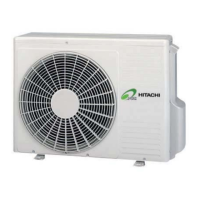29
INSTALLATION AND OPERATION MANUAL
ENGLISH
11.4.2. TWIN, TRIPLE AND QUAD SYSTEM
INSTALLATION
Height Difference Between Indoor Units and Distributor
Install all indoor units at the same height. When the height difference
between the indoor units due to building construction is necessary,
this should be less than H
in
(m). Install the branch pipe at the same
height of indoor units or lower, but never higher.
Sample: Twin system
Indoor unit
Indoor unit
Height Difference between two
indoors smaller than H
in
(m)
Smaller than H
in
(m)
Branch pipe
Maximum Height
difference between
Indoor units
H
in
H(V)RNM(1)E 3.0
HVRNS1E 0.5
Installing Distributor
1. Install the Distributor supplied by HITACHI on request.
A tee can not be installed instead of a branch pipe.
Sample: Twin System
2. Installing the Distributor.
Fix the branch pipe horizontally to the pillar, wall or ceiling. Piping
must not be xed rigidly to the wall as thermal expansion and
contraction can cause pipe fracture.
Sample: Twin System
Horizontal
To Indoor
Unit
To Outdoor unit
Vertical
To Indoor unit
Fixing the branch pipe to
the surface of pillar or wall
Horizontal
Horizontal
Fixing the branch pipe to
ceiling or beam
NOTE:
Fix the piping from outside of insulation or inserting absorber
between the pipe and a xing metal.
3. Correct position of twin distributor (available also for quad installation)
- This is the correct position of twin Branch Pipe:
Greater
than 0.5 m
Main pipe
Refrigerant direction
Up
Branch pipe
Main pipe
Refrigerant
direction
Down
- This is wrong position.
Main pipe
Refrigerant direction
Branch pipe
Branch pipe
Refrigerant
direction
Branch pipe
Main pipe
4. Correct position of Triple Branch Pipe.
- Install the header horizontally
Sample: Triple Branch pipe
Gas piping
Liquid piping
11.4.3. BRAZING WORK
ATTENTION:
Use nitrogen gas for blowing during pipe brazing. If oxygen,
acetylene or uorocarbon gas is used, it will cause an explosion or
poisonous gas.
A lot of oxidation lm will occur inside of tubes if no nitrogen gas
blowing is performed during brazing work. This lm will be ecked
off after operation and will circulate in the cycle, resulting in
clogged expansion valves, etc. This will cause bad inuence to the
compressor.
Use a reducer valve when nitrogen gas blowing is performed
during brazing. The gas pressure should be maintained within 0.03
to 0.05 Mpa. If a excessively high pressure is applied to a pipe, it
will cause an explosion.
11.4.4. REFRIGERANT CHARGE
CAUTION:
Do not charge OXYGEN, ACETYLENE, or other ammable and
poisonous gases into the refrigerant because an explosion can
occur. It is recommended that oxygen free nitrogen be charged for
these types of tests cycle when performing a leakage test or an
airtight test. These types of gases are extremely dangerous,
Insulate the unions and are-nuts at the piping connection part
completely.
Insulate the liquid piping completely to avoid a decrease of
performance; if not, it will cause sweating on the surface of the
pipe.
Charge refrigerant correctly. Overcharging or insufcient charging
could cause a compressor failure.
Check for refrigerant leakage in detail. If a large refrigerant
leakage occurred, it would cause difculty with breathing or
harmful gases would occur if a re were being used in the room.
If the are nut is tigthened too hard, the are nut may crack after a
long time and cause refrigerant leakage.
PMML0197_r0_04-10.indb 29 08/07/2010 9:20:46

